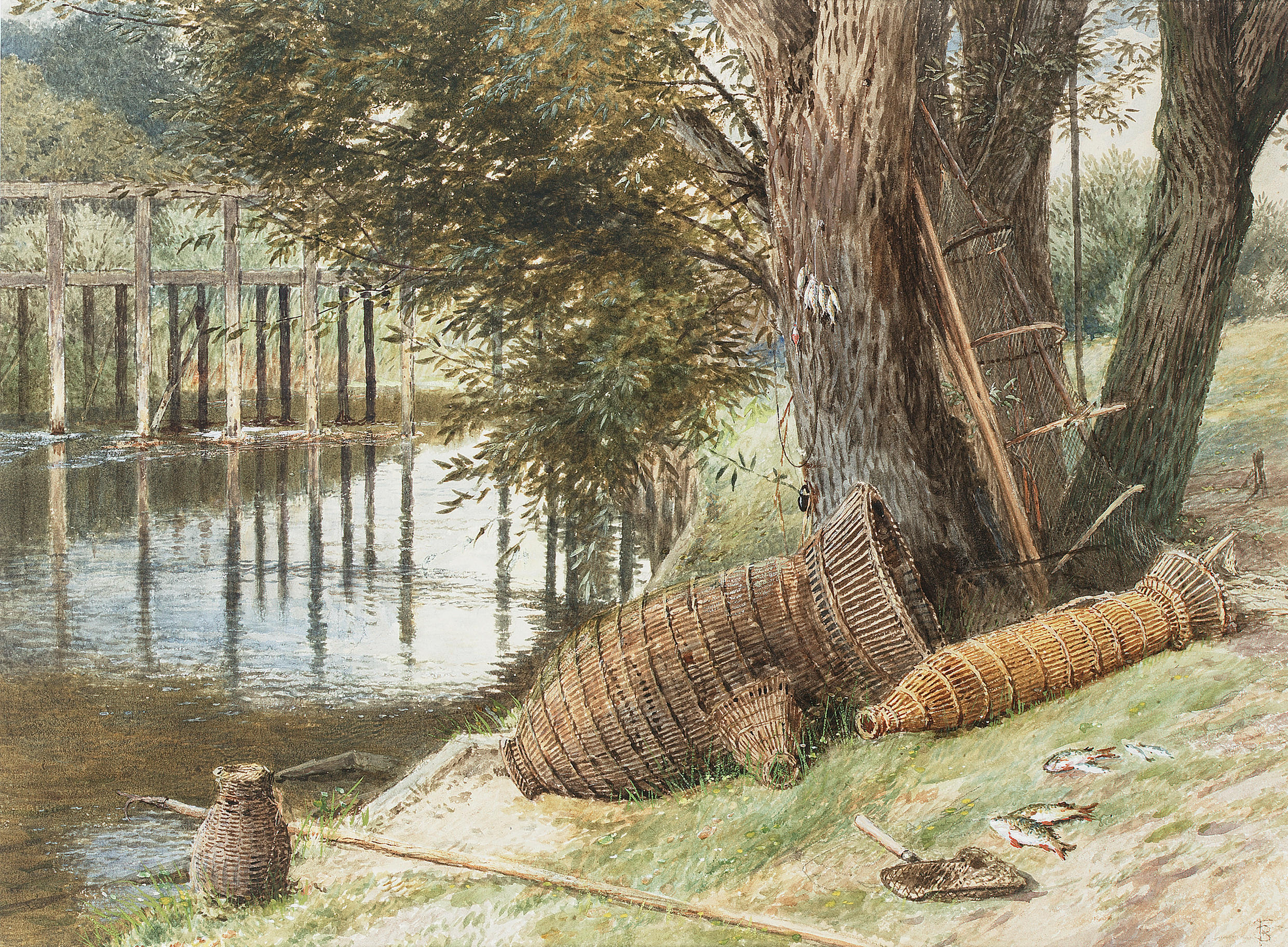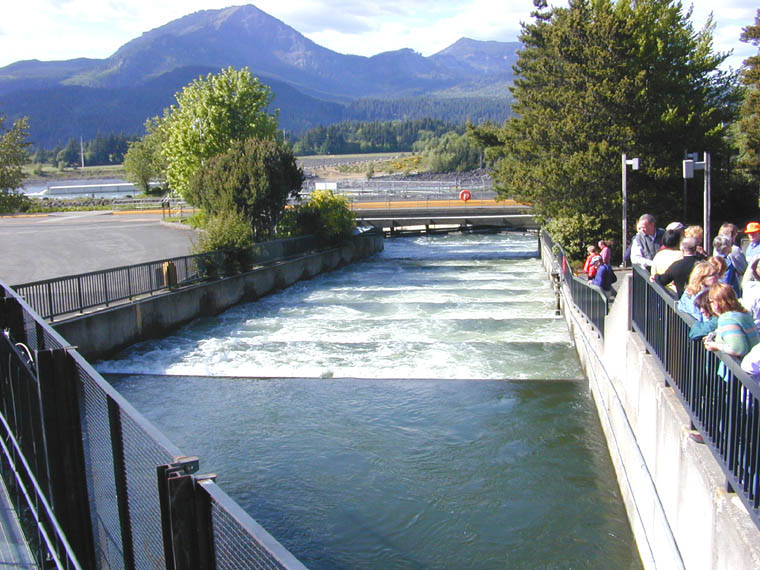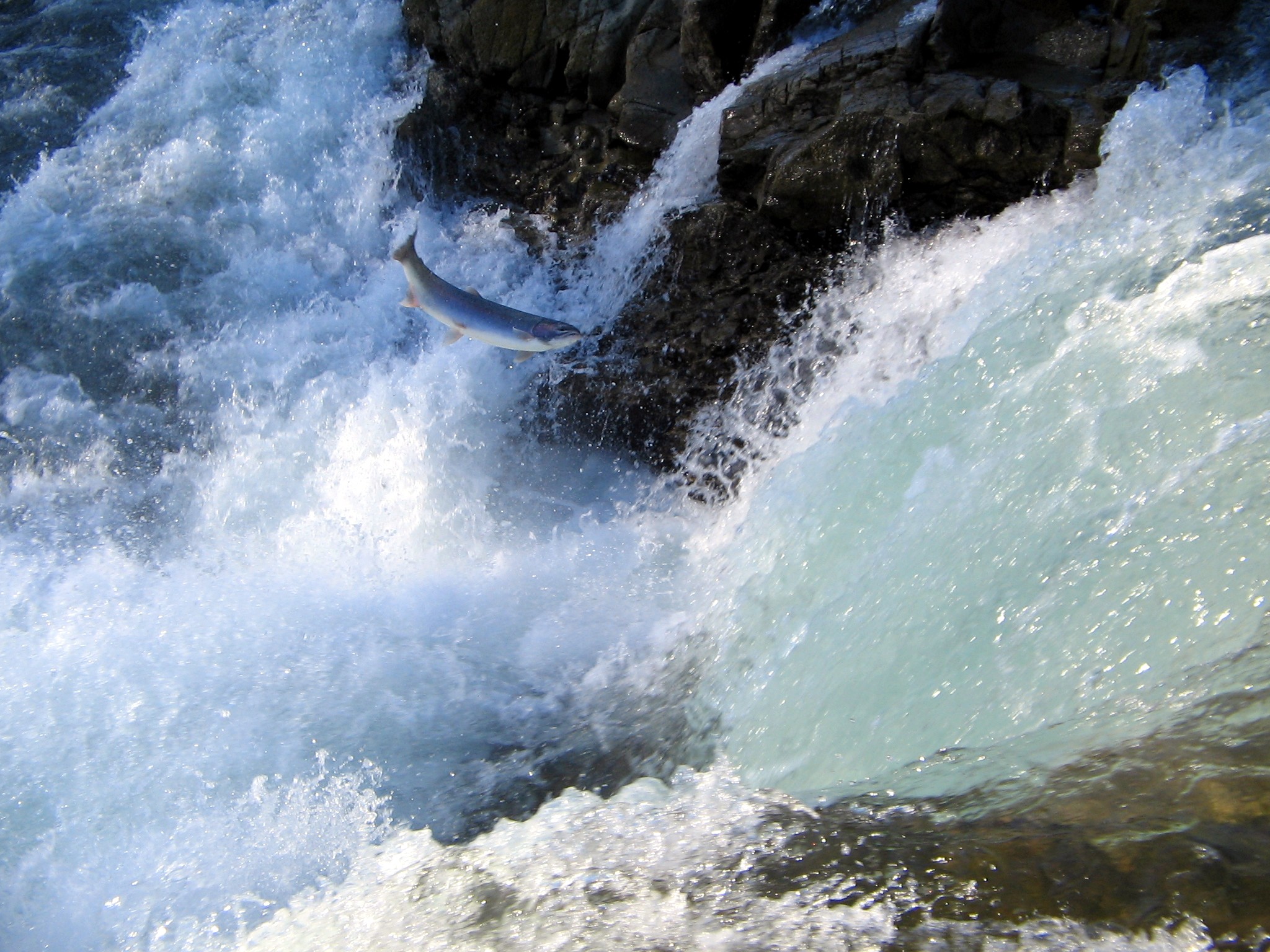|
Fish Counter
Automatic fish counters are automatic devices for measuring the number of fish passing along a particular river in a particular period of time. Usually one particular species is of interest. One important species studied by fish counters are Atlantic salmon. This species is of interest owing to its ecologically vulnerable status and anadromous lifestyles. Methods of operation Fish counters can be divided into three principal types: resistive counters, optical counters, and hydroacoustic counters. Resistive counters A resistive counter is associated with an in-river structure, an example constituting a Crump weir. The resistivity of a fish is lower than that of water. So, as fish cross this barrier, they pass embedded electrodes, and the difference in resistivity disturbs the field established in the vicinity of the electrodes, altering inter-electrode resistance. With three electrodes these disturbances can then be measured by a Wheatstone bridge, or other means, to detect ... [...More Info...] [...Related Items...] OR: [Wikipedia] [Google] [Baidu] |
Atlantic Salmon
The Atlantic salmon (''Salmo salar'') is a species of ray-finned fish in the family Salmonidae. It is the third largest of the Salmonidae, behind Hucho taimen, Siberian taimen and Pacific Chinook salmon, growing up to a meter in length. Atlantic salmon are found in the northern Atlantic Ocean and in rivers that flow into it. Most populations are anadromous, hatching in streams and rivers but moving out to sea as they grow where they mature, after which the adults seasonally move upstream again to spawn. When the mature fish re-enter rivers to spawn, they change in colour and appearance. Some populations of this fish only migrate to large lakes, and are "landlocked", spending their entire lives in freshwater. Such populations are found throughout the range of the species. Unlike Pacific species of salmon, ''S. salar'' is iteroparous, which means it can survive spawning and return to sea to repeat the process again in another year with 5–10% returning to the sea to spawn again ... [...More Info...] [...Related Items...] OR: [Wikipedia] [Google] [Baidu] |
Swimbladder
The swim bladder, gas bladder, fish maw, or air bladder is an internal gas-filled organ in bony fish that functions to modulate buoyancy, and thus allowing the fish to stay at desired water depth without having to maintain lift via swimming, which expends more energy. Also, the dorsal position of the swim bladder means that the expansion of the bladder moves the center of mass downwards, allowing it to act as a stabilizing apparatus. Additionally, the swim bladder functions as a resonating chamber to produce or receive sound. The swim bladder is evolutionarily homologous to the lungs of tetrapods and lungfish, and some ray-finned fish such as bowfins have also evolved similar respiratory functions in their swim bladders. Charles Darwin remarked upon this in ''On the Origin of Species'', and reasoned that the lung in air-breathing vertebrates had derived from a more primitive swim bladder as a specialized form of enteral respiration. Some species, such as mostly bottom dwe ... [...More Info...] [...Related Items...] OR: [Wikipedia] [Google] [Baidu] |
Aquatic Ecology
An aquatic ecosystem is an ecosystem found in and around a body of water, in contrast to land-based terrestrial ecosystems. Aquatic ecosystems contain communities of organisms—aquatic life—that are dependent on each other and on their environment. The two main types of aquatic ecosystems are marine ecosystems and freshwater ecosystems. Freshwater ecosystems may be lentic (slow moving water, including pools, ponds, and lakes); lotic (faster moving water, for example streams and rivers); and wetlands (areas where the soil is saturated or inundated for at least part of the time). Types Marine ecosystems Marine coastal ecosystem Marine surface ecosystem Freshwater ecosystems Lentic ecosystem (lakes) Lotic ecosystem (rivers) Wetlands Functions Aquatic ecosystems perform many important environmental functions. For example, they recycle nutrients, purify water, attenuate floods, recharge ground water and provide habitats for wildlife. The biota of an aqua ... [...More Info...] [...Related Items...] OR: [Wikipedia] [Google] [Baidu] |
Spawn (biology)
Spawn is the eggs and sperm released or deposited into water by aquatic animals. As a verb, ''to spawn'' refers to the process of freely releasing eggs and sperm into a body of water (fresh or marine); the physical act is known as spawning. The vast majority of aquatic and amphibious animals reproduce through spawning. These include the following groups: * Bony fishes * Crustaceans (such as crabs, shrimps, etc.) *Mollusks (such as oysters, octopus, squid) *Echinoderms (such as sea urchins, sea stars, sea cucumbers, etc.) * Amphibians (such as frogs, toads, salamanders, newts) * Aquatic insects (such as dragonflies, mayflies, mosquitoes) *Coral, which are living colonies of tiny, aquatic organisms—not plants, as they are sometimes perceived to be. Corals, while appearing sedentary or botanical by nature, actually spawn by releasing clouds of sperm and egg cells into the water column, where the two mix. As a general rule, aquatic or semiaquatic reptiles, birds, ... [...More Info...] [...Related Items...] OR: [Wikipedia] [Google] [Baidu] |
Fish Trap
A fish trap is a animal trapping, trap used for fishing, catching fish and other aquatic animals of value. Fish traps include fishing weirs, lobster trap, cage traps, fish wheels and some fishing net rigs such as fyke nets. The use of traps are culturally almost universal around the world and seem to have been independently invented many times. There are two main types of trap, a permanent or semi-permanent structure placed in a river or tidal area and bottle or pot trap that are usually, but not always baited to attract prey, and are periodically lifted out of the water. A typical contemporary trap consists of a frame of thick steel wire in the shape of a heart, with chicken wire stretched around it. The mesh wraps around the frame and then tapers into the inside of the trap. Fishes that swim inside through this opening cannot get out, as the chicken wire opening bends back into its original narrowness. In earlier times, traps were constructed of wood and fibre. Fish traps con ... [...More Info...] [...Related Items...] OR: [Wikipedia] [Google] [Baidu] |
Electrofishing
Electrofishing is a fishing technique that uses direct current electricity flowing between a submerged cathode and anode. This affects the movements of nearby fish so that they swim toward the anode, where they can be caught or stunned."FISHNET SHOCKINGS" . ''Toronto Star'', December 3, page IN3. Paul Hunter Electrofishing is a common scientific survey method used to sample fish populations to determine abundance, population density and . When performed correctly, electr ... [...More Info...] [...Related Items...] OR: [Wikipedia] [Google] [Baidu] |
Fish Ladder
A fish ladder, also known as a fishway, fish pass, fish steps, or fish cannon, is a structure on or around artificial and natural barriers (such as dams, locks and waterfalls) to facilitate diadromous fishes' natural migration as well as movements of potamodromous species. Most fishways enable fish to pass around the barriers by swimming and leaping up a series of relatively low steps (hence the term ''ladder'') into the waters on the other side. The velocity of water falling over the steps has to be great enough to attract the fish to the ladder, but it cannot be so great that it washes fish back downstream or exhausts them to the point of inability to continue their journey upriver. History Written reports of rough fishways date to 17th-century France, where bundles of branches were used to make steps in steep channels to bypass obstructions. A 1714 construction of an old channel bypassing a dam, "originally cut for the passage of fish up and down the river", is mentio ... [...More Info...] [...Related Items...] OR: [Wikipedia] [Google] [Baidu] |
Fishing Weir
A fishing weir, fish weir, fishgarth or kiddle is an obstruction placed in tidal waters, or wholly or partially across a river, to direct the passage of, or trap fish. A weir may be used to trap marine fish in the intertidal zone as the tide recedes, fish such as salmon as they attempt to swim upstream to breed in a river, or eels as they migrate downstream. Alternatively, fish weirs can be used to channel fish to a particular location, such as to a fish ladder. Weirs were traditionally built from wood or stones. The use of fishing weirs as fish traps probably dates back prior to the emergence of modern humans, and have since been used by many societies around the world. In the Philippines, specific indigenous fishing weirs (a version of the ancient Austronesian stone fish weirs) are also known in English as fish corrals and barrier nets. Etymology The English word 'weir' comes from the Anglo-Saxon ''wer,'' one meaning of which is a device to trap fish. By region Africa A ... [...More Info...] [...Related Items...] OR: [Wikipedia] [Google] [Baidu] |
Sonar
Sonar (sound navigation and ranging or sonic navigation and ranging) is a technique that uses sound propagation (usually underwater, as in submarine navigation) to navigate, measure distances ( ranging), communicate with or detect objects on or under the surface of the water, such as other vessels. "Sonar" can refer to one of two types of technology: ''passive'' sonar means listening for the sound made by vessels; ''active'' sonar means emitting pulses of sounds and listening for echoes. Sonar may be used as a means of acoustic location and of measurement of the echo characteristics of "targets" in the water. Acoustic location in air was used before the introduction of radar. Sonar may also be used for robot navigation, and sodar (an upward-looking in-air sonar) is used for atmospheric investigations. The term ''sonar'' is also used for the equipment used to generate and receive the sound. The acoustic frequencies used in sonar systems vary from very low ( infrasonic) to e ... [...More Info...] [...Related Items...] OR: [Wikipedia] [Google] [Baidu] |
Fish Migration
Fish migration is mass relocation by fish from one area or body of water to another. Many types of fish migrate on a regular basis, on time scales ranging from daily to annually or longer, and over distances ranging from a few metres to thousands of kilometres. Such migrations are usually done for better feeding or to reproduce, but in other cases the reasons are unclear. Fish migrations involve movements of schools of fish on a scale and duration larger than those arising during normal daily activities. Some particular types of migration are ''anadromous'', in which adult fish live in the sea and migrate into fresh water to spawn; and ''catadromous'', in which adult fish live in fresh water and migrate into salt water to spawn. Marine forage fish often make large migrations between their spawning, feeding and nursery grounds. Their movements are associated with ocean currents and with the availability of food in different areas at different times of the year. The migratory ... [...More Info...] [...Related Items...] OR: [Wikipedia] [Google] [Baidu] |
Sea Trout
Sea trout is the common name usually applied to anadromous (sea-run) forms of brown trout (''Salmo trutta''), and is often referred to as ''Salmo trutta'' morpha ''trutta''. Other names for anadromous brown trout are bull trout, sewin (Wales), peel or peal (southwest England), mort (northwest England), finnock (Scotland), white trout (Ireland) and salmon trout (culinary). The term "sea trout" is also used to describe other anadromous salmonids, such as coho salmon (''Oncorhynchus kisutch''), coastal cutthroat trout (''Oncorhynchus clarkii clarkii''), brook trout (''Salvelinus fontinalis''), Arctic char (''Salvelinus alpinus alpinus'') and Dolly Varden (''Salvenlinus malma''). Even some non-salmonid fish species are also commonly known as sea trout, such as Northern pikeminnow (''Ptychocheilus oregonensis'') and members of the weakfish family (''Cynoscion''). Range Anadromous brown trout are widely distributed in Europe along the Atlantic and Baltic coasts, the United Kin ... [...More Info...] [...Related Items...] OR: [Wikipedia] [Google] [Baidu] |
Closed-circuit Television
Closed-circuit television (CCTV), also known as video surveillance, is the use of closed-circuit television cameras to transmit a signal to a specific place on a limited set of monitors. It differs from broadcast television in that the signal is not openly transmitted, though it may employ point-to-point, point-to-multipoint (P2MP), or mesh wired or wireless links. Even though almost all video cameras fit this definition, the term is most often applied to those used for surveillance in areas that require additional security or ongoing monitoring ( videotelephony is seldom called "CCTV"). The deployment of this technology has facilitated significant growth in state surveillance, a substantial rise in the methods of advanced social monitoring and control, and a host of crime prevention measures throughout the world. Though surveillance of the public using CCTV is common in many areas around the world, video surveillance has generated significant debate about balancing its us ... [...More Info...] [...Related Items...] OR: [Wikipedia] [Google] [Baidu] |









